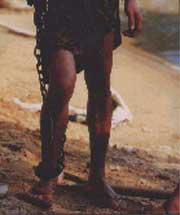 On
February 8th, the documentary on Burma that took five
years to create was screened at the Directors' Guild
of America Theatres in New York City. The screening
event was organized by Dr. Zarni, the founder of Free
Burma Coalition (FBC),
to promote the awareness of the dreadful human right violations
taking place in Burma. The documentary titled, 'Anatomy
Of Terror' is narrated by Oscar Award winning actress
Susan Sarandon, who was at the event to support Burma's
struggle for freedom. A week later, the documentary was
screened again at Free Burma Coalition's sixth annual
working conference in Washington DC. Lorne Craner, the
assistant secretary of state for democracy, human rights,
and labor, gave the opening address of the conference,
emphasizing the importance of realizing what is going
on in Burma and to give support to the Burmese people.
On
February 8th, the documentary on Burma that took five
years to create was screened at the Directors' Guild
of America Theatres in New York City. The screening
event was organized by Dr. Zarni, the founder of Free
Burma Coalition (FBC),
to promote the awareness of the dreadful human right violations
taking place in Burma. The documentary titled, 'Anatomy
Of Terror' is narrated by Oscar Award winning actress
Susan Sarandon, who was at the event to support Burma's
struggle for freedom. A week later, the documentary was
screened again at Free Burma Coalition's sixth annual
working conference in Washington DC. Lorne Craner, the
assistant secretary of state for democracy, human rights,
and labor, gave the opening address of the conference,
emphasizing the importance of realizing what is going
on in Burma and to give support to the Burmese people.
It is important to realize that Burma is a country with
several ethnic groups ruled by a  ruthless
dictator. The regime controls all the political and economical
activities in the country. The civilians are not allowed
to form any type of political organization. What about
students? Do they have a chance to start up a club or
a union? No. Everything has to be done secretly and if
the government finds out, the union members are imprisoned
or sentenced to death. “I got the death penalty
on December of 1989 because of my involvement in politics,”
says Moe Thee Zun, one of the student activists during
the 1988 Burma nationwide demonstration and was the chairman
of Democracy for New Society. In fact, the regime resembles
a paranoid person who sees everyone that is outside of
their inner circle as potential enemies. These potential
enemies include elderly women, children, monks, and religiously
affiliated people. This regime has violated human rights
many times just to keep them in power.
ruthless
dictator. The regime controls all the political and economical
activities in the country. The civilians are not allowed
to form any type of political organization. What about
students? Do they have a chance to start up a club or
a union? No. Everything has to be done secretly and if
the government finds out, the union members are imprisoned
or sentenced to death. “I got the death penalty
on December of 1989 because of my involvement in politics,”
says Moe Thee Zun, one of the student activists during
the 1988 Burma nationwide demonstration and was the chairman
of Democracy for New Society. In fact, the regime resembles
a paranoid person who sees everyone that is outside of
their inner circle as potential enemies. These potential
enemies include elderly women, children, monks, and religiously
affiliated people. This regime has violated human rights
many times just to keep them in power.
During the 1988 nationwide demonstration, in which an
outbreak started from the killing of two students by officials,
an estimate of 30,000 died and 40,000 ran away into the
jungles. In a speech given to the public during the protest
by the dictator general Nay Win, he emphasized, “…
the military shoots so that it hits and kill.” Universities
and schools were closed for four years after the incident.
Those who went into the jungles got in touch with minor
ethnic groups and kept on fighting the military regime
for fourteen years.
The lifestyle of Burmese people could be observed through
the country’s economy. Three years ago, the currency
exchange for one dollar in US money was around 100 kyats.
Today, the exchange rate is around 1,000 kyats. This is
the black market value. The official  exchange
rate according to the government is 6 kyats because it
gives them the advantage when kyats are converted into
dollar. The people suffer from inflation too. Inflation
is triggered by the increased production of money by the
government whenever it is needed. While the salary for
a clerk is 10,000 kyats, a shirt might cost 3,000 kyats.
exchange
rate according to the government is 6 kyats because it
gives them the advantage when kyats are converted into
dollar. The people suffer from inflation too. Inflation
is triggered by the increased production of money by the
government whenever it is needed. While the salary for
a clerk is 10,000 kyats, a shirt might cost 3,000 kyats.
Burmese citizens in the country side also become victims
of forced labor. Nearly more than 90% of the village population
in the country sides is forced to work for the military.
They perform tasks such as carrying weapons, building
roads, factories, mining, and any inhuman work that is
possible. The required blue collar labor for state owned
factories comes from porters. The profit goes into strengthening
the weaponry that will be used upon its own citizens and
expanding its alliance with drug lords.
These drug lords have expanded their territory into the
cities. Their sphere of influence has developed onto a
level that cannot be stopped or ticketed if they ran through
a red light. Ordinary people can establish any type of
industry or companies they desire. However, their businesses
have a limit and to bypass that limit, the connection
with a higher level military official is necessary. “I
accidentally put info on the political and economical
situations in Burma. The next day, the intelligence is
knocking on my door,” says one of the managers of
a web design company in Rangoon.
With the country’s economic system entirely in the
lurch, the education sector cannot be improved.
Students were not given required resources to complete
their education. “The Youth generation in Burma
was systematically destroyed by the military regime. The
universities and institutions in Burma are closed often
and at the same time, most of the universities are relocated
to isolate areas,” says Aung Thu Naing, who fled
to Thai-Burma border after the military crackdown of the
1988 demonstration. The students in the country side cannot
afford books or pencils. A school merely resembles a rickety
hut. Schools in the cities are crowded and there are at
least 60 students in every class. There is an absence
of good libraries and schools’ sanitation systems
are poor due to lack of maintenance. Schools rarely have
a library and if they do, the books cannot be used by
the students. One of the students in the country’s
top school, who declined to mention her name, says, “There
are a lot of books in the library. But the problem is
that all of them are locked. Forget about reading them,
we are not even able to touch them. All we read was comics
and useless journals that tell you what to wear and what
the fashion trends are.” No wonder she does not
know who Napoleon was. There is only a short summary about
the French Revolution in her history text book highlighting
important dates and battles. It does not comment on why
and how the revolution started. Students are taught to
memorize facts without any philosophical reasoning. “Students
in Burma don’t have good curriculums,” says
Aung Thu Naing, “The main concern of the military
is that future students will take power from the military.
So the military won’t include anything in the text
books that will incite philosophical ideas.”
What is the future of the Burmese people? One thing is
for sure on their living standards. “People are living a dead life. There are no options
for them,” says Ko Ko Aung, who is a broadcaster
for Burmese service at Radio Free Asia. The atrocities
going on in Burma are invisible in the international community.
The unseen terror is consuming the daily lives of Burmese
citizens as a wild fire. The future generation is being
systematically destroyed. The human rights violations
going on in Burma needs recognition.
“People are living a dead life. There are no options
for them,” says Ko Ko Aung, who is a broadcaster
for Burmese service at Radio Free Asia. The atrocities
going on in Burma are invisible in the international community.
The unseen terror is consuming the daily lives of Burmese
citizens as a wild fire. The future generation is being
systematically destroyed. The human rights violations
going on in Burma needs recognition.
Free Burma Coalition, one of the many Burmese activist
organizations, has been organizing events to promote the
awareness of the situations in Burma. The organization,
with its affiliates in 28 countries, has been working
to stop the flow of currency provided by multinational
corporations in Burma. Free Burma Coalition has performed
successful campaigns that have affected the military government.
However, the support of the international community is
needed to weaken the military dictatorship. This is the
only way the Burmese citizens will be able to carry out
their daily lives peacefully.